Organizational Behavior Analysis: Recruiter Perception in Interviews
VerifiedAdded on 2022/10/19
|10
|2266
|298
Report
AI Summary
This report analyzes the impact of recruiter perception on candidate selection during job interviews, focusing on organizational behavior principles. It examines various perceptual errors, including the halo and recency effects, and how these biases can influence hiring decisions. The report explores the negative stereotypes that recruiters may hold and how these can hinder candidates from expressing themselves fully, as well as the Pygmalion and Galatea effects. It further discusses the importance of candidates honestly addressing their weaknesses and how recruiters can assess candidates based on their behavior. The report emphasizes the need for recruiters to avoid personal beliefs and stereotypes, and instead, evaluate candidates based on objective standards and authentic circumstances. The analysis incorporates various research studies to support the findings, providing a comprehensive overview of the topic.
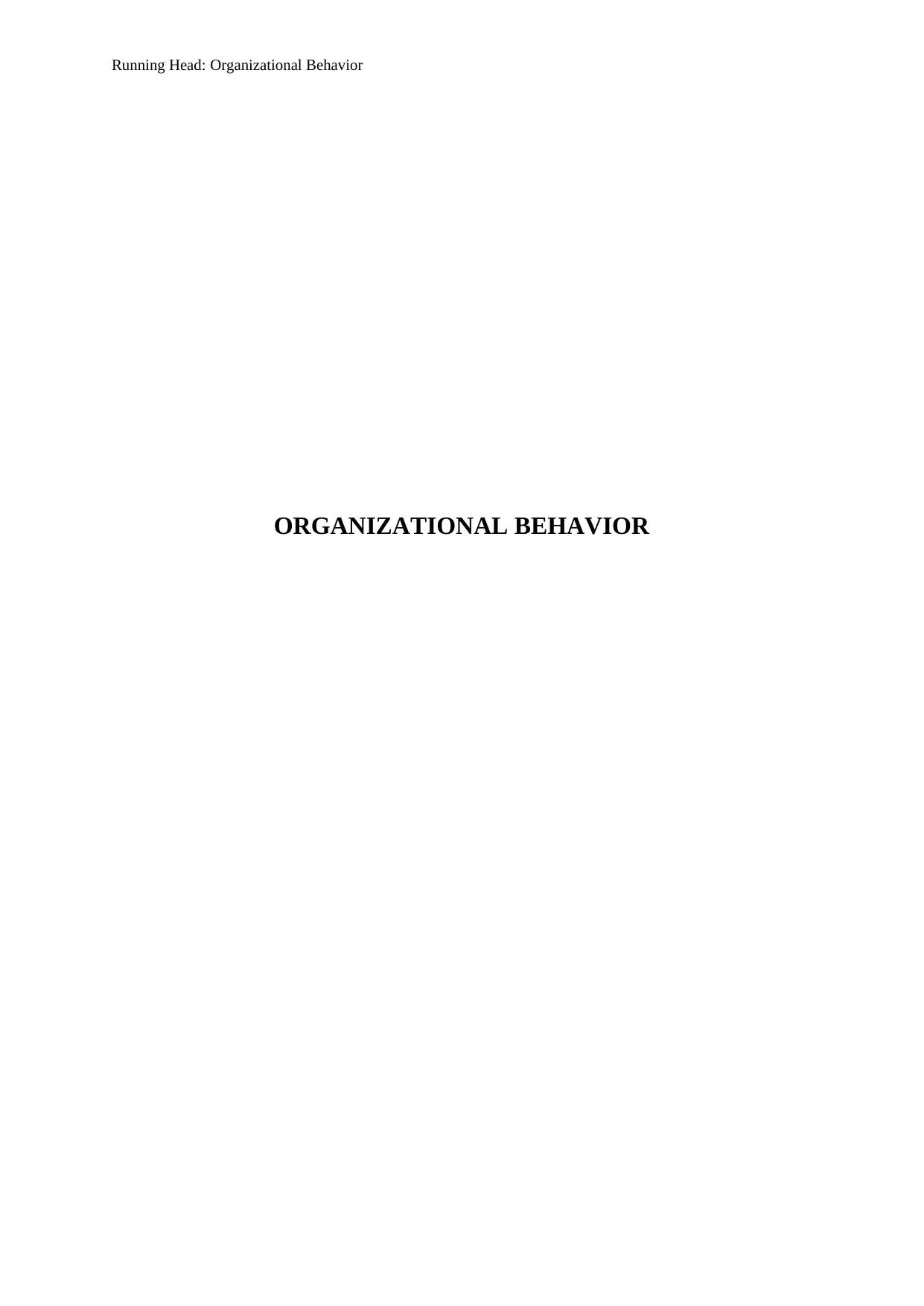
Running Head: Organizational Behavior
ORGANIZATIONAL BEHAVIOR
ORGANIZATIONAL BEHAVIOR
Paraphrase This Document
Need a fresh take? Get an instant paraphrase of this document with our AI Paraphraser
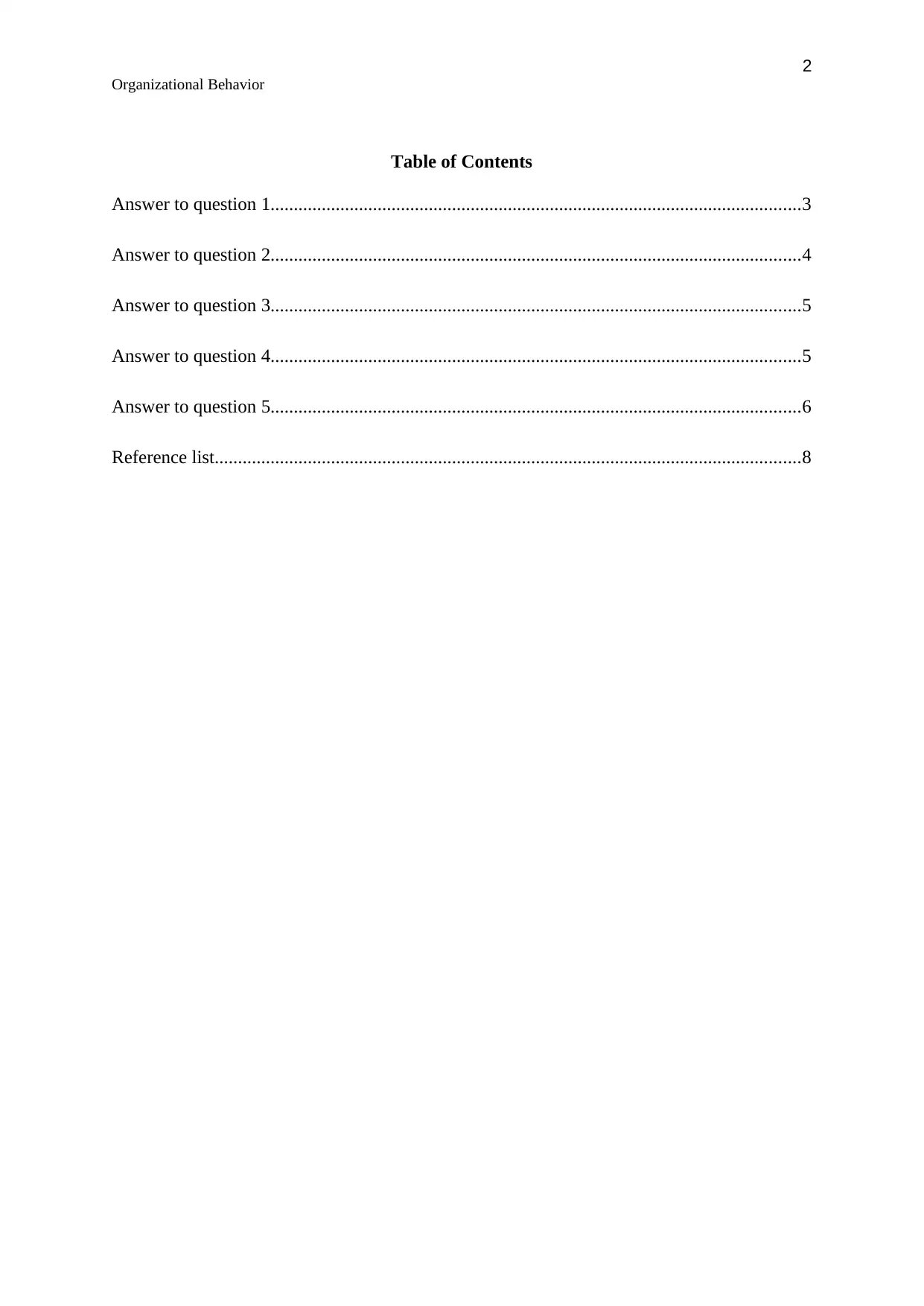
2
Organizational Behavior
Table of Contents
Answer to question 1..................................................................................................................3
Answer to question 2..................................................................................................................4
Answer to question 3..................................................................................................................5
Answer to question 4..................................................................................................................5
Answer to question 5..................................................................................................................6
Reference list..............................................................................................................................8
Organizational Behavior
Table of Contents
Answer to question 1..................................................................................................................3
Answer to question 2..................................................................................................................4
Answer to question 3..................................................................................................................5
Answer to question 4..................................................................................................................5
Answer to question 5..................................................................................................................6
Reference list..............................................................................................................................8
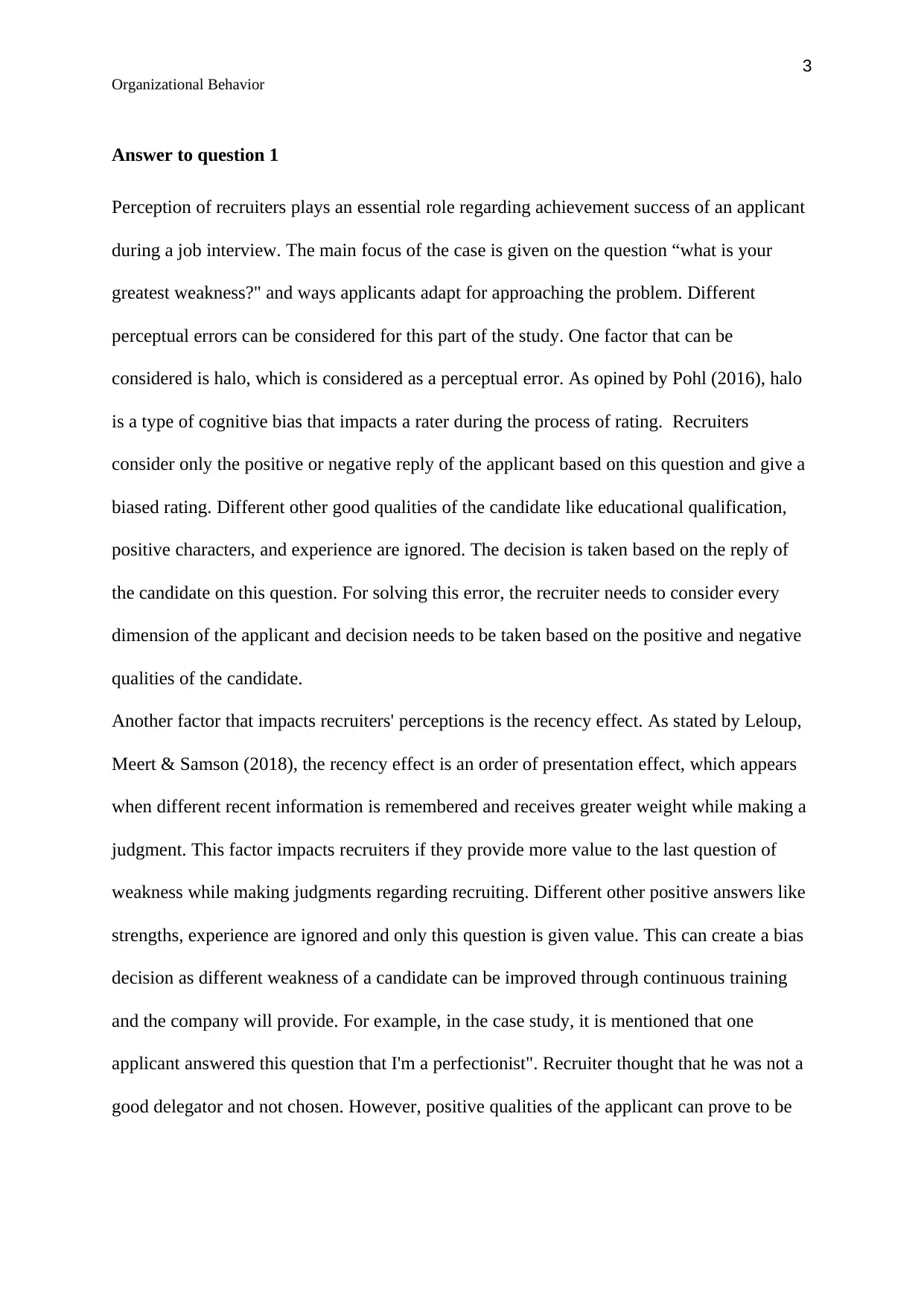
3
Organizational Behavior
Answer to question 1
Perception of recruiters plays an essential role regarding achievement success of an applicant
during a job interview. The main focus of the case is given on the question “what is your
greatest weakness?" and ways applicants adapt for approaching the problem. Different
perceptual errors can be considered for this part of the study. One factor that can be
considered is halo, which is considered as a perceptual error. As opined by Pohl (2016), halo
is a type of cognitive bias that impacts a rater during the process of rating. Recruiters
consider only the positive or negative reply of the applicant based on this question and give a
biased rating. Different other good qualities of the candidate like educational qualification,
positive characters, and experience are ignored. The decision is taken based on the reply of
the candidate on this question. For solving this error, the recruiter needs to consider every
dimension of the applicant and decision needs to be taken based on the positive and negative
qualities of the candidate.
Another factor that impacts recruiters' perceptions is the recency effect. As stated by Leloup,
Meert & Samson (2018), the recency effect is an order of presentation effect, which appears
when different recent information is remembered and receives greater weight while making a
judgment. This factor impacts recruiters if they provide more value to the last question of
weakness while making judgments regarding recruiting. Different other positive answers like
strengths, experience are ignored and only this question is given value. This can create a bias
decision as different weakness of a candidate can be improved through continuous training
and the company will provide. For example, in the case study, it is mentioned that one
applicant answered this question that I'm a perfectionist". Recruiter thought that he was not a
good delegator and not chosen. However, positive qualities of the applicant can prove to be
Organizational Behavior
Answer to question 1
Perception of recruiters plays an essential role regarding achievement success of an applicant
during a job interview. The main focus of the case is given on the question “what is your
greatest weakness?" and ways applicants adapt for approaching the problem. Different
perceptual errors can be considered for this part of the study. One factor that can be
considered is halo, which is considered as a perceptual error. As opined by Pohl (2016), halo
is a type of cognitive bias that impacts a rater during the process of rating. Recruiters
consider only the positive or negative reply of the applicant based on this question and give a
biased rating. Different other good qualities of the candidate like educational qualification,
positive characters, and experience are ignored. The decision is taken based on the reply of
the candidate on this question. For solving this error, the recruiter needs to consider every
dimension of the applicant and decision needs to be taken based on the positive and negative
qualities of the candidate.
Another factor that impacts recruiters' perceptions is the recency effect. As stated by Leloup,
Meert & Samson (2018), the recency effect is an order of presentation effect, which appears
when different recent information is remembered and receives greater weight while making a
judgment. This factor impacts recruiters if they provide more value to the last question of
weakness while making judgments regarding recruiting. Different other positive answers like
strengths, experience are ignored and only this question is given value. This can create a bias
decision as different weakness of a candidate can be improved through continuous training
and the company will provide. For example, in the case study, it is mentioned that one
applicant answered this question that I'm a perfectionist". Recruiter thought that he was not a
good delegator and not chosen. However, positive qualities of the applicant can prove to be
⊘ This is a preview!⊘
Do you want full access?
Subscribe today to unlock all pages.

Trusted by 1+ million students worldwide
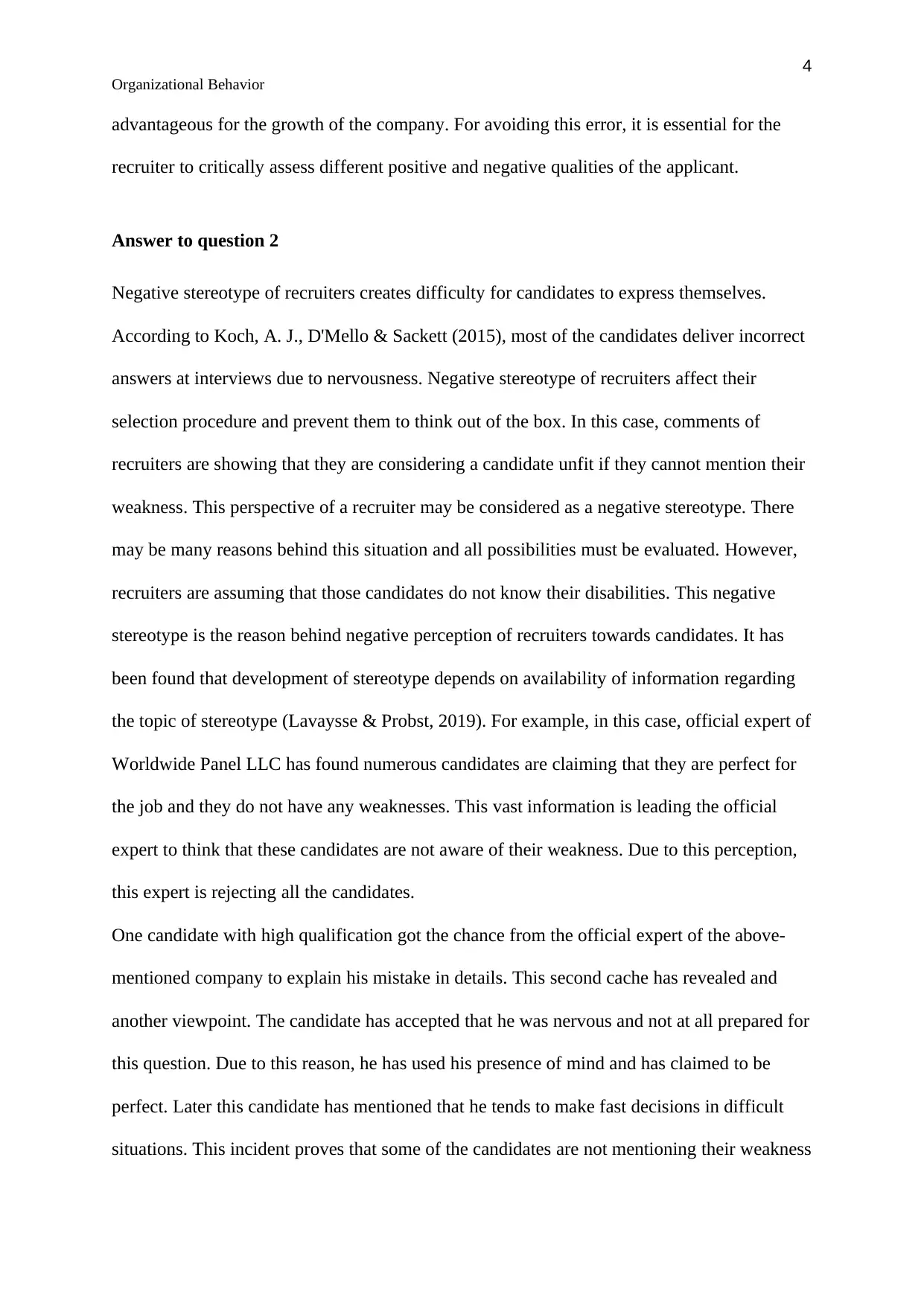
4
Organizational Behavior
advantageous for the growth of the company. For avoiding this error, it is essential for the
recruiter to critically assess different positive and negative qualities of the applicant.
Answer to question 2
Negative stereotype of recruiters creates difficulty for candidates to express themselves.
According to Koch, A. J., D'Mello & Sackett (2015), most of the candidates deliver incorrect
answers at interviews due to nervousness. Negative stereotype of recruiters affect their
selection procedure and prevent them to think out of the box. In this case, comments of
recruiters are showing that they are considering a candidate unfit if they cannot mention their
weakness. This perspective of a recruiter may be considered as a negative stereotype. There
may be many reasons behind this situation and all possibilities must be evaluated. However,
recruiters are assuming that those candidates do not know their disabilities. This negative
stereotype is the reason behind negative perception of recruiters towards candidates. It has
been found that development of stereotype depends on availability of information regarding
the topic of stereotype (Lavaysse & Probst, 2019). For example, in this case, official expert of
Worldwide Panel LLC has found numerous candidates are claiming that they are perfect for
the job and they do not have any weaknesses. This vast information is leading the official
expert to think that these candidates are not aware of their weakness. Due to this perception,
this expert is rejecting all the candidates.
One candidate with high qualification got the chance from the official expert of the above-
mentioned company to explain his mistake in details. This second cache has revealed and
another viewpoint. The candidate has accepted that he was nervous and not at all prepared for
this question. Due to this reason, he has used his presence of mind and has claimed to be
perfect. Later this candidate has mentioned that he tends to make fast decisions in difficult
situations. This incident proves that some of the candidates are not mentioning their weakness
Organizational Behavior
advantageous for the growth of the company. For avoiding this error, it is essential for the
recruiter to critically assess different positive and negative qualities of the applicant.
Answer to question 2
Negative stereotype of recruiters creates difficulty for candidates to express themselves.
According to Koch, A. J., D'Mello & Sackett (2015), most of the candidates deliver incorrect
answers at interviews due to nervousness. Negative stereotype of recruiters affect their
selection procedure and prevent them to think out of the box. In this case, comments of
recruiters are showing that they are considering a candidate unfit if they cannot mention their
weakness. This perspective of a recruiter may be considered as a negative stereotype. There
may be many reasons behind this situation and all possibilities must be evaluated. However,
recruiters are assuming that those candidates do not know their disabilities. This negative
stereotype is the reason behind negative perception of recruiters towards candidates. It has
been found that development of stereotype depends on availability of information regarding
the topic of stereotype (Lavaysse & Probst, 2019). For example, in this case, official expert of
Worldwide Panel LLC has found numerous candidates are claiming that they are perfect for
the job and they do not have any weaknesses. This vast information is leading the official
expert to think that these candidates are not aware of their weakness. Due to this perception,
this expert is rejecting all the candidates.
One candidate with high qualification got the chance from the official expert of the above-
mentioned company to explain his mistake in details. This second cache has revealed and
another viewpoint. The candidate has accepted that he was nervous and not at all prepared for
this question. Due to this reason, he has used his presence of mind and has claimed to be
perfect. Later this candidate has mentioned that he tends to make fast decisions in difficult
situations. This incident proves that some of the candidates are not mentioning their weakness
Paraphrase This Document
Need a fresh take? Get an instant paraphrase of this document with our AI Paraphraser
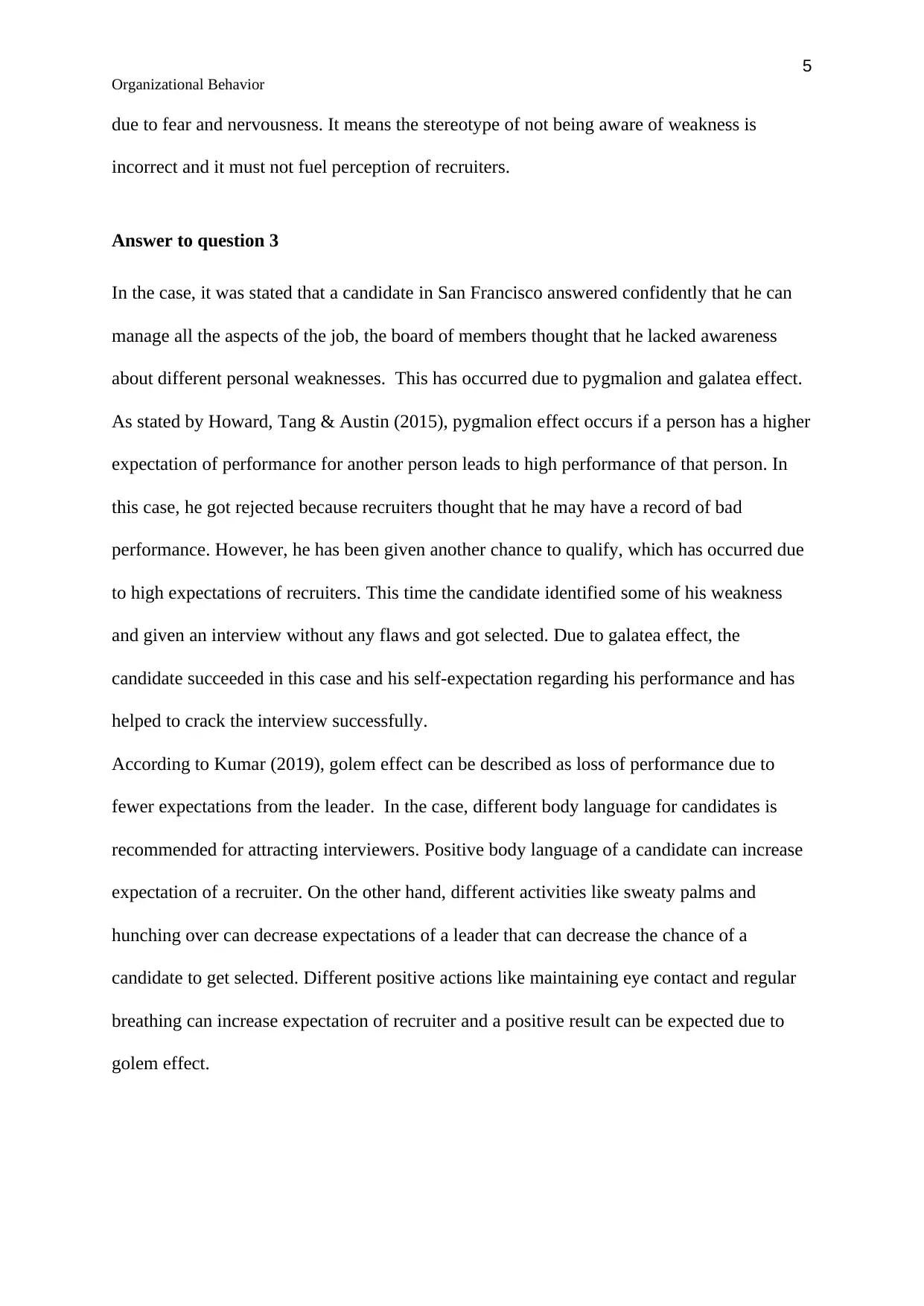
5
Organizational Behavior
due to fear and nervousness. It means the stereotype of not being aware of weakness is
incorrect and it must not fuel perception of recruiters.
Answer to question 3
In the case, it was stated that a candidate in San Francisco answered confidently that he can
manage all the aspects of the job, the board of members thought that he lacked awareness
about different personal weaknesses. This has occurred due to pygmalion and galatea effect.
As stated by Howard, Tang & Austin (2015), pygmalion effect occurs if a person has a higher
expectation of performance for another person leads to high performance of that person. In
this case, he got rejected because recruiters thought that he may have a record of bad
performance. However, he has been given another chance to qualify, which has occurred due
to high expectations of recruiters. This time the candidate identified some of his weakness
and given an interview without any flaws and got selected. Due to galatea effect, the
candidate succeeded in this case and his self-expectation regarding his performance and has
helped to crack the interview successfully.
According to Kumar (2019), golem effect can be described as loss of performance due to
fewer expectations from the leader. In the case, different body language for candidates is
recommended for attracting interviewers. Positive body language of a candidate can increase
expectation of a recruiter. On the other hand, different activities like sweaty palms and
hunching over can decrease expectations of a leader that can decrease the chance of a
candidate to get selected. Different positive actions like maintaining eye contact and regular
breathing can increase expectation of recruiter and a positive result can be expected due to
golem effect.
Organizational Behavior
due to fear and nervousness. It means the stereotype of not being aware of weakness is
incorrect and it must not fuel perception of recruiters.
Answer to question 3
In the case, it was stated that a candidate in San Francisco answered confidently that he can
manage all the aspects of the job, the board of members thought that he lacked awareness
about different personal weaknesses. This has occurred due to pygmalion and galatea effect.
As stated by Howard, Tang & Austin (2015), pygmalion effect occurs if a person has a higher
expectation of performance for another person leads to high performance of that person. In
this case, he got rejected because recruiters thought that he may have a record of bad
performance. However, he has been given another chance to qualify, which has occurred due
to high expectations of recruiters. This time the candidate identified some of his weakness
and given an interview without any flaws and got selected. Due to galatea effect, the
candidate succeeded in this case and his self-expectation regarding his performance and has
helped to crack the interview successfully.
According to Kumar (2019), golem effect can be described as loss of performance due to
fewer expectations from the leader. In the case, different body language for candidates is
recommended for attracting interviewers. Positive body language of a candidate can increase
expectation of a recruiter. On the other hand, different activities like sweaty palms and
hunching over can decrease expectations of a leader that can decrease the chance of a
candidate to get selected. Different positive actions like maintaining eye contact and regular
breathing can increase expectation of recruiter and a positive result can be expected due to
golem effect.
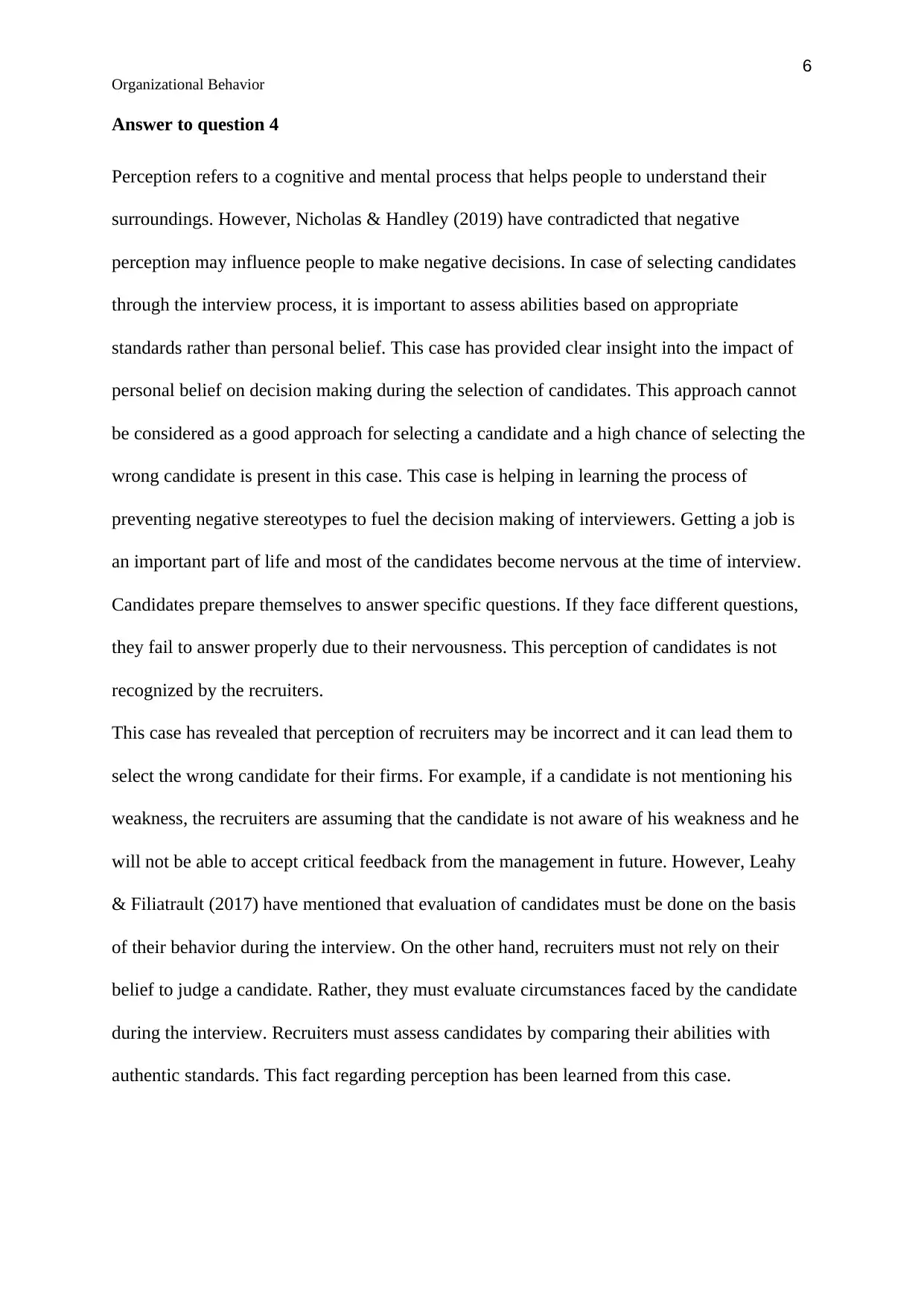
6
Organizational Behavior
Answer to question 4
Perception refers to a cognitive and mental process that helps people to understand their
surroundings. However, Nicholas & Handley (2019) have contradicted that negative
perception may influence people to make negative decisions. In case of selecting candidates
through the interview process, it is important to assess abilities based on appropriate
standards rather than personal belief. This case has provided clear insight into the impact of
personal belief on decision making during the selection of candidates. This approach cannot
be considered as a good approach for selecting a candidate and a high chance of selecting the
wrong candidate is present in this case. This case is helping in learning the process of
preventing negative stereotypes to fuel the decision making of interviewers. Getting a job is
an important part of life and most of the candidates become nervous at the time of interview.
Candidates prepare themselves to answer specific questions. If they face different questions,
they fail to answer properly due to their nervousness. This perception of candidates is not
recognized by the recruiters.
This case has revealed that perception of recruiters may be incorrect and it can lead them to
select the wrong candidate for their firms. For example, if a candidate is not mentioning his
weakness, the recruiters are assuming that the candidate is not aware of his weakness and he
will not be able to accept critical feedback from the management in future. However, Leahy
& Filiatrault (2017) have mentioned that evaluation of candidates must be done on the basis
of their behavior during the interview. On the other hand, recruiters must not rely on their
belief to judge a candidate. Rather, they must evaluate circumstances faced by the candidate
during the interview. Recruiters must assess candidates by comparing their abilities with
authentic standards. This fact regarding perception has been learned from this case.
Organizational Behavior
Answer to question 4
Perception refers to a cognitive and mental process that helps people to understand their
surroundings. However, Nicholas & Handley (2019) have contradicted that negative
perception may influence people to make negative decisions. In case of selecting candidates
through the interview process, it is important to assess abilities based on appropriate
standards rather than personal belief. This case has provided clear insight into the impact of
personal belief on decision making during the selection of candidates. This approach cannot
be considered as a good approach for selecting a candidate and a high chance of selecting the
wrong candidate is present in this case. This case is helping in learning the process of
preventing negative stereotypes to fuel the decision making of interviewers. Getting a job is
an important part of life and most of the candidates become nervous at the time of interview.
Candidates prepare themselves to answer specific questions. If they face different questions,
they fail to answer properly due to their nervousness. This perception of candidates is not
recognized by the recruiters.
This case has revealed that perception of recruiters may be incorrect and it can lead them to
select the wrong candidate for their firms. For example, if a candidate is not mentioning his
weakness, the recruiters are assuming that the candidate is not aware of his weakness and he
will not be able to accept critical feedback from the management in future. However, Leahy
& Filiatrault (2017) have mentioned that evaluation of candidates must be done on the basis
of their behavior during the interview. On the other hand, recruiters must not rely on their
belief to judge a candidate. Rather, they must evaluate circumstances faced by the candidate
during the interview. Recruiters must assess candidates by comparing their abilities with
authentic standards. This fact regarding perception has been learned from this case.
⊘ This is a preview!⊘
Do you want full access?
Subscribe today to unlock all pages.

Trusted by 1+ million students worldwide
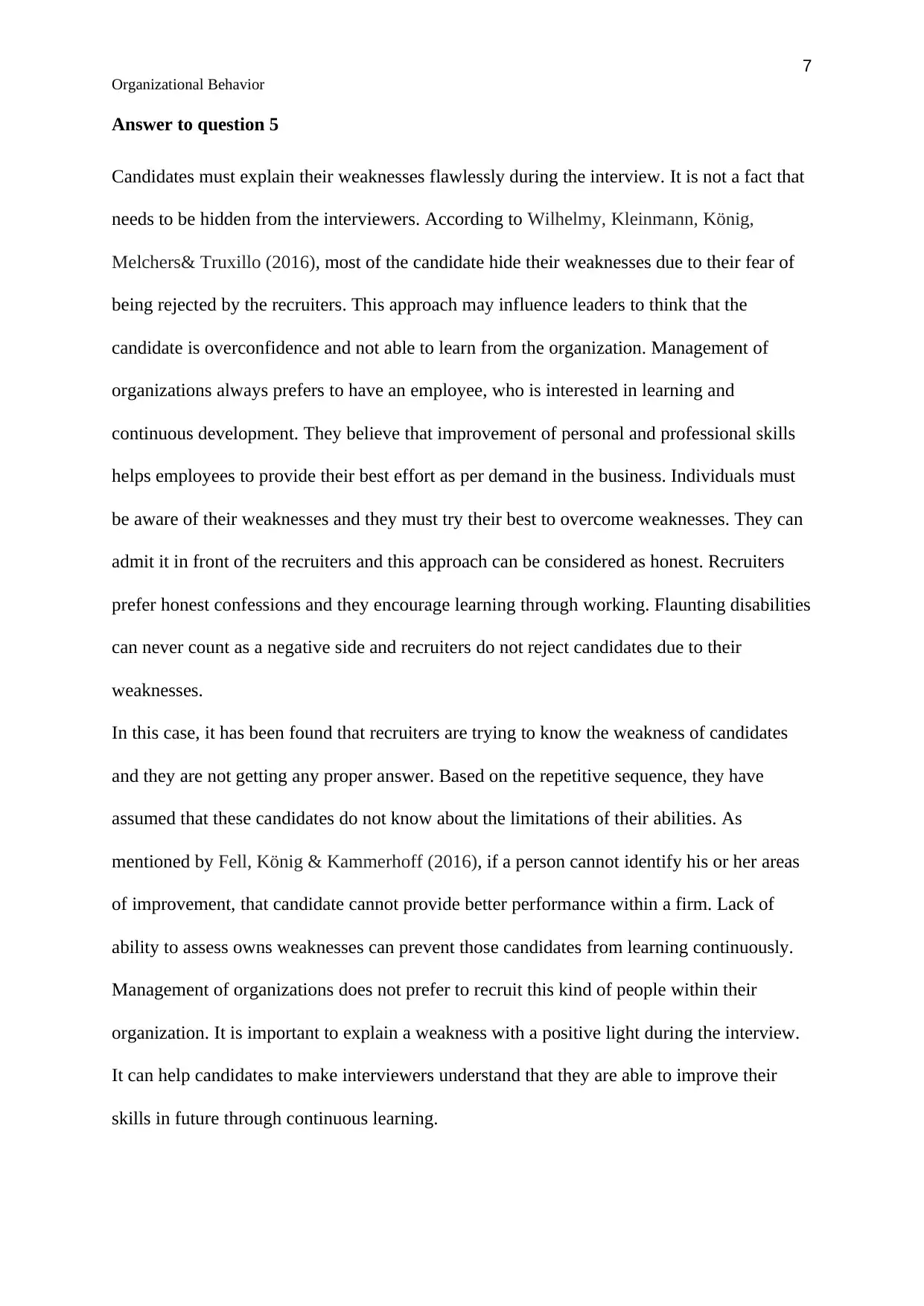
7
Organizational Behavior
Answer to question 5
Candidates must explain their weaknesses flawlessly during the interview. It is not a fact that
needs to be hidden from the interviewers. According to Wilhelmy, Kleinmann, König,
Melchers& Truxillo (2016), most of the candidate hide their weaknesses due to their fear of
being rejected by the recruiters. This approach may influence leaders to think that the
candidate is overconfidence and not able to learn from the organization. Management of
organizations always prefers to have an employee, who is interested in learning and
continuous development. They believe that improvement of personal and professional skills
helps employees to provide their best effort as per demand in the business. Individuals must
be aware of their weaknesses and they must try their best to overcome weaknesses. They can
admit it in front of the recruiters and this approach can be considered as honest. Recruiters
prefer honest confessions and they encourage learning through working. Flaunting disabilities
can never count as a negative side and recruiters do not reject candidates due to their
weaknesses.
In this case, it has been found that recruiters are trying to know the weakness of candidates
and they are not getting any proper answer. Based on the repetitive sequence, they have
assumed that these candidates do not know about the limitations of their abilities. As
mentioned by Fell, König & Kammerhoff (2016), if a person cannot identify his or her areas
of improvement, that candidate cannot provide better performance within a firm. Lack of
ability to assess owns weaknesses can prevent those candidates from learning continuously.
Management of organizations does not prefer to recruit this kind of people within their
organization. It is important to explain a weakness with a positive light during the interview.
It can help candidates to make interviewers understand that they are able to improve their
skills in future through continuous learning.
Organizational Behavior
Answer to question 5
Candidates must explain their weaknesses flawlessly during the interview. It is not a fact that
needs to be hidden from the interviewers. According to Wilhelmy, Kleinmann, König,
Melchers& Truxillo (2016), most of the candidate hide their weaknesses due to their fear of
being rejected by the recruiters. This approach may influence leaders to think that the
candidate is overconfidence and not able to learn from the organization. Management of
organizations always prefers to have an employee, who is interested in learning and
continuous development. They believe that improvement of personal and professional skills
helps employees to provide their best effort as per demand in the business. Individuals must
be aware of their weaknesses and they must try their best to overcome weaknesses. They can
admit it in front of the recruiters and this approach can be considered as honest. Recruiters
prefer honest confessions and they encourage learning through working. Flaunting disabilities
can never count as a negative side and recruiters do not reject candidates due to their
weaknesses.
In this case, it has been found that recruiters are trying to know the weakness of candidates
and they are not getting any proper answer. Based on the repetitive sequence, they have
assumed that these candidates do not know about the limitations of their abilities. As
mentioned by Fell, König & Kammerhoff (2016), if a person cannot identify his or her areas
of improvement, that candidate cannot provide better performance within a firm. Lack of
ability to assess owns weaknesses can prevent those candidates from learning continuously.
Management of organizations does not prefer to recruit this kind of people within their
organization. It is important to explain a weakness with a positive light during the interview.
It can help candidates to make interviewers understand that they are able to improve their
skills in future through continuous learning.
Paraphrase This Document
Need a fresh take? Get an instant paraphrase of this document with our AI Paraphraser
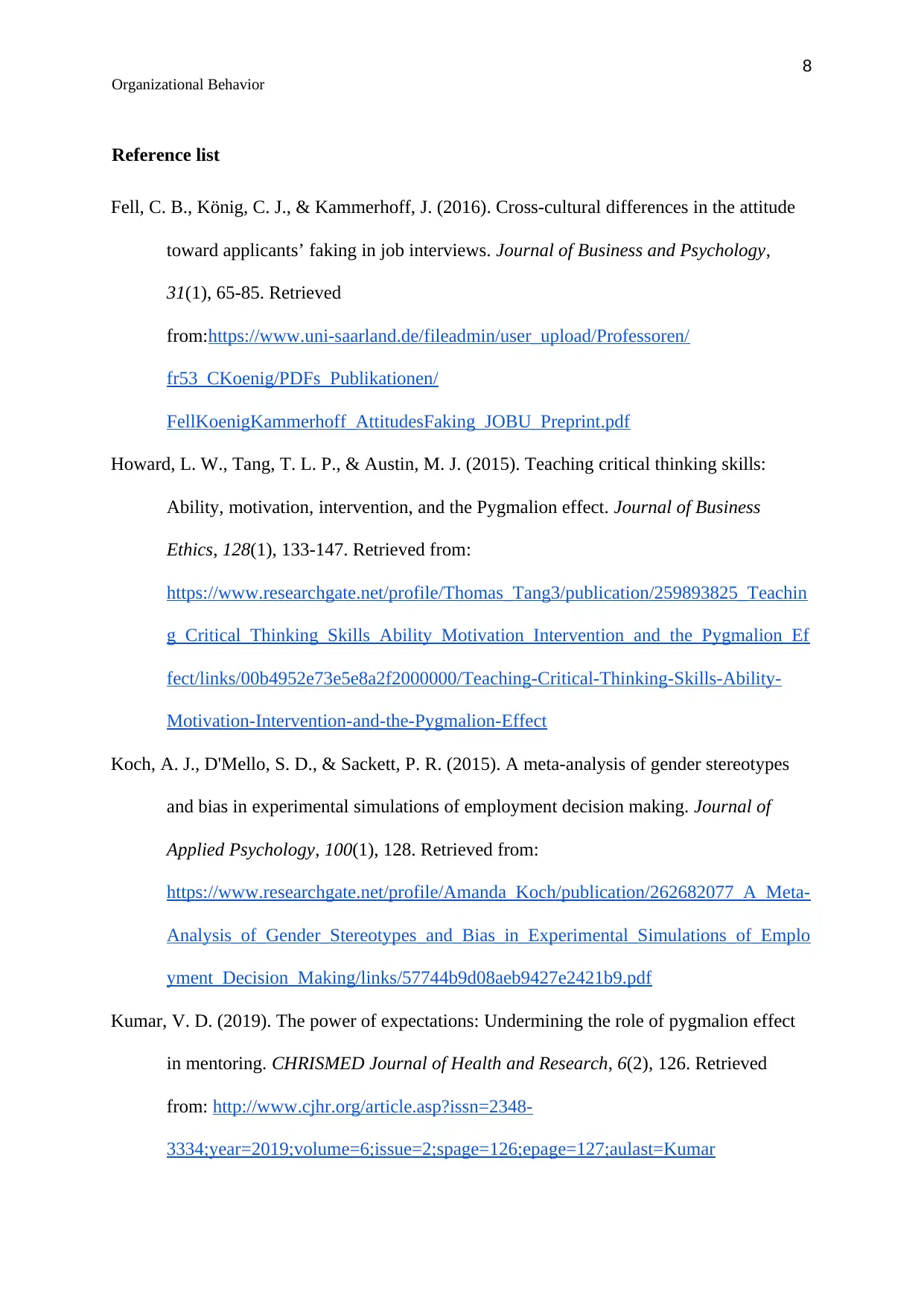
8
Organizational Behavior
Reference list
Fell, C. B., König, C. J., & Kammerhoff, J. (2016). Cross-cultural differences in the attitude
toward applicants’ faking in job interviews. Journal of Business and Psychology,
31(1), 65-85. Retrieved
from:https://www.uni-saarland.de/fileadmin/user_upload/Professoren/
fr53_CKoenig/PDFs_Publikationen/
FellKoenigKammerhoff_AttitudesFaking_JOBU_Preprint.pdf
Howard, L. W., Tang, T. L. P., & Austin, M. J. (2015). Teaching critical thinking skills:
Ability, motivation, intervention, and the Pygmalion effect. Journal of Business
Ethics, 128(1), 133-147. Retrieved from:
https://www.researchgate.net/profile/Thomas_Tang3/publication/259893825_Teachin
g_Critical_Thinking_Skills_Ability_Motivation_Intervention_and_the_Pygmalion_Ef
fect/links/00b4952e73e5e8a2f2000000/Teaching-Critical-Thinking-Skills-Ability-
Motivation-Intervention-and-the-Pygmalion-Effect
Koch, A. J., D'Mello, S. D., & Sackett, P. R. (2015). A meta-analysis of gender stereotypes
and bias in experimental simulations of employment decision making. Journal of
Applied Psychology, 100(1), 128. Retrieved from:
https://www.researchgate.net/profile/Amanda_Koch/publication/262682077_A_Meta-
Analysis_of_Gender_Stereotypes_and_Bias_in_Experimental_Simulations_of_Emplo
yment_Decision_Making/links/57744b9d08aeb9427e2421b9.pdf
Kumar, V. D. (2019). The power of expectations: Undermining the role of pygmalion effect
in mentoring. CHRISMED Journal of Health and Research, 6(2), 126. Retrieved
from: http://www.cjhr.org/article.asp?issn=2348-
3334;year=2019;volume=6;issue=2;spage=126;epage=127;aulast=Kumar
Organizational Behavior
Reference list
Fell, C. B., König, C. J., & Kammerhoff, J. (2016). Cross-cultural differences in the attitude
toward applicants’ faking in job interviews. Journal of Business and Psychology,
31(1), 65-85. Retrieved
from:https://www.uni-saarland.de/fileadmin/user_upload/Professoren/
fr53_CKoenig/PDFs_Publikationen/
FellKoenigKammerhoff_AttitudesFaking_JOBU_Preprint.pdf
Howard, L. W., Tang, T. L. P., & Austin, M. J. (2015). Teaching critical thinking skills:
Ability, motivation, intervention, and the Pygmalion effect. Journal of Business
Ethics, 128(1), 133-147. Retrieved from:
https://www.researchgate.net/profile/Thomas_Tang3/publication/259893825_Teachin
g_Critical_Thinking_Skills_Ability_Motivation_Intervention_and_the_Pygmalion_Ef
fect/links/00b4952e73e5e8a2f2000000/Teaching-Critical-Thinking-Skills-Ability-
Motivation-Intervention-and-the-Pygmalion-Effect
Koch, A. J., D'Mello, S. D., & Sackett, P. R. (2015). A meta-analysis of gender stereotypes
and bias in experimental simulations of employment decision making. Journal of
Applied Psychology, 100(1), 128. Retrieved from:
https://www.researchgate.net/profile/Amanda_Koch/publication/262682077_A_Meta-
Analysis_of_Gender_Stereotypes_and_Bias_in_Experimental_Simulations_of_Emplo
yment_Decision_Making/links/57744b9d08aeb9427e2421b9.pdf
Kumar, V. D. (2019). The power of expectations: Undermining the role of pygmalion effect
in mentoring. CHRISMED Journal of Health and Research, 6(2), 126. Retrieved
from: http://www.cjhr.org/article.asp?issn=2348-
3334;year=2019;volume=6;issue=2;spage=126;epage=127;aulast=Kumar
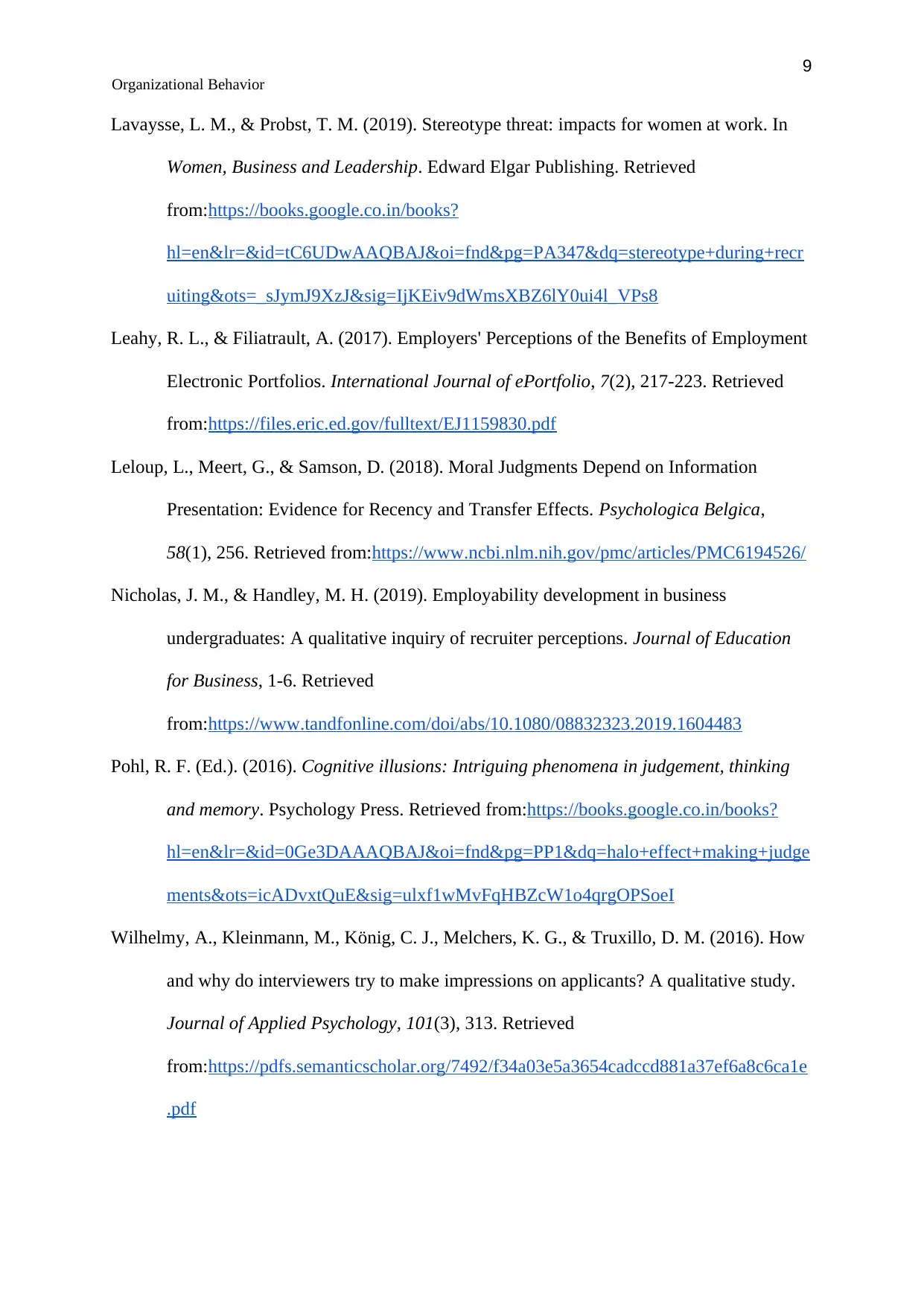
9
Organizational Behavior
Lavaysse, L. M., & Probst, T. M. (2019). Stereotype threat: impacts for women at work. In
Women, Business and Leadership. Edward Elgar Publishing. Retrieved
from:https://books.google.co.in/books?
hl=en&lr=&id=tC6UDwAAQBAJ&oi=fnd&pg=PA347&dq=stereotype+during+recr
uiting&ots=_sJymJ9XzJ&sig=IjKEiv9dWmsXBZ6lY0ui4l_VPs8
Leahy, R. L., & Filiatrault, A. (2017). Employers' Perceptions of the Benefits of Employment
Electronic Portfolios. International Journal of ePortfolio, 7(2), 217-223. Retrieved
from:https://files.eric.ed.gov/fulltext/EJ1159830.pdf
Leloup, L., Meert, G., & Samson, D. (2018). Moral Judgments Depend on Information
Presentation: Evidence for Recency and Transfer Effects. Psychologica Belgica,
58(1), 256. Retrieved from:https://www.ncbi.nlm.nih.gov/pmc/articles/PMC6194526/
Nicholas, J. M., & Handley, M. H. (2019). Employability development in business
undergraduates: A qualitative inquiry of recruiter perceptions. Journal of Education
for Business, 1-6. Retrieved
from:https://www.tandfonline.com/doi/abs/10.1080/08832323.2019.1604483
Pohl, R. F. (Ed.). (2016). Cognitive illusions: Intriguing phenomena in judgement, thinking
and memory. Psychology Press. Retrieved from:https://books.google.co.in/books?
hl=en&lr=&id=0Ge3DAAAQBAJ&oi=fnd&pg=PP1&dq=halo+effect+making+judge
ments&ots=icADvxtQuE&sig=ulxf1wMvFqHBZcW1o4qrgOPSoeI
Wilhelmy, A., Kleinmann, M., König, C. J., Melchers, K. G., & Truxillo, D. M. (2016). How
and why do interviewers try to make impressions on applicants? A qualitative study.
Journal of Applied Psychology, 101(3), 313. Retrieved
from:https://pdfs.semanticscholar.org/7492/f34a03e5a3654cadccd881a37ef6a8c6ca1e
.pdf
Organizational Behavior
Lavaysse, L. M., & Probst, T. M. (2019). Stereotype threat: impacts for women at work. In
Women, Business and Leadership. Edward Elgar Publishing. Retrieved
from:https://books.google.co.in/books?
hl=en&lr=&id=tC6UDwAAQBAJ&oi=fnd&pg=PA347&dq=stereotype+during+recr
uiting&ots=_sJymJ9XzJ&sig=IjKEiv9dWmsXBZ6lY0ui4l_VPs8
Leahy, R. L., & Filiatrault, A. (2017). Employers' Perceptions of the Benefits of Employment
Electronic Portfolios. International Journal of ePortfolio, 7(2), 217-223. Retrieved
from:https://files.eric.ed.gov/fulltext/EJ1159830.pdf
Leloup, L., Meert, G., & Samson, D. (2018). Moral Judgments Depend on Information
Presentation: Evidence for Recency and Transfer Effects. Psychologica Belgica,
58(1), 256. Retrieved from:https://www.ncbi.nlm.nih.gov/pmc/articles/PMC6194526/
Nicholas, J. M., & Handley, M. H. (2019). Employability development in business
undergraduates: A qualitative inquiry of recruiter perceptions. Journal of Education
for Business, 1-6. Retrieved
from:https://www.tandfonline.com/doi/abs/10.1080/08832323.2019.1604483
Pohl, R. F. (Ed.). (2016). Cognitive illusions: Intriguing phenomena in judgement, thinking
and memory. Psychology Press. Retrieved from:https://books.google.co.in/books?
hl=en&lr=&id=0Ge3DAAAQBAJ&oi=fnd&pg=PP1&dq=halo+effect+making+judge
ments&ots=icADvxtQuE&sig=ulxf1wMvFqHBZcW1o4qrgOPSoeI
Wilhelmy, A., Kleinmann, M., König, C. J., Melchers, K. G., & Truxillo, D. M. (2016). How
and why do interviewers try to make impressions on applicants? A qualitative study.
Journal of Applied Psychology, 101(3), 313. Retrieved
from:https://pdfs.semanticscholar.org/7492/f34a03e5a3654cadccd881a37ef6a8c6ca1e
⊘ This is a preview!⊘
Do you want full access?
Subscribe today to unlock all pages.

Trusted by 1+ million students worldwide
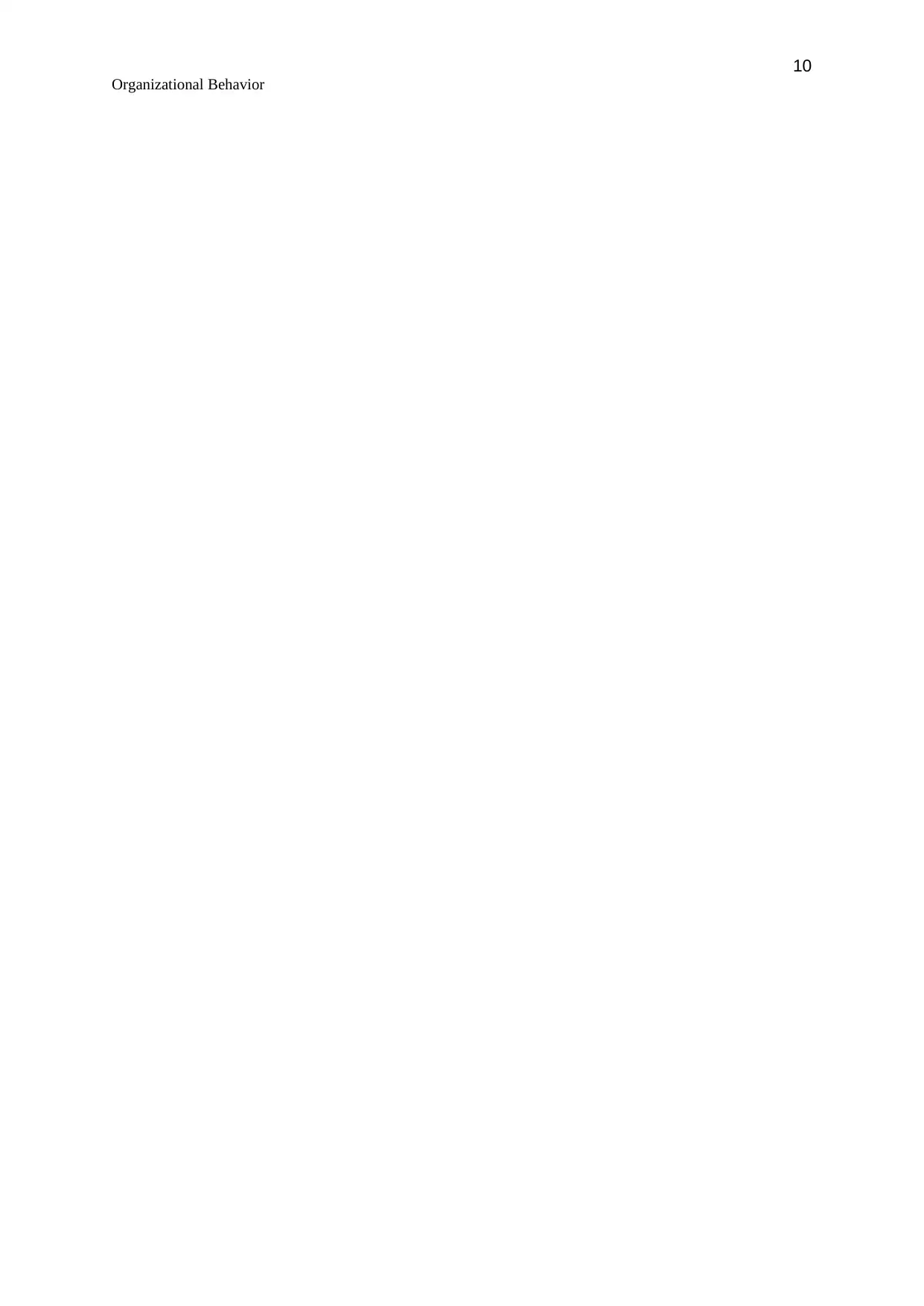
10
Organizational Behavior
Organizational Behavior
1 out of 10
Your All-in-One AI-Powered Toolkit for Academic Success.
+13062052269
info@desklib.com
Available 24*7 on WhatsApp / Email
![[object Object]](/_next/static/media/star-bottom.7253800d.svg)
Unlock your academic potential
Copyright © 2020–2025 A2Z Services. All Rights Reserved. Developed and managed by ZUCOL.


